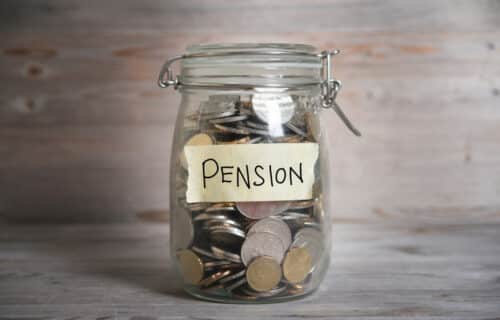When you’re ready to retire, you’ll need more than just Social Security to cover your expenses. These benefits are often only adequate to replace roughly 40% of normal earnings.
You should have either a traditional pension plan or a defined contribution plan, such as a 401(k) account, to live comfortably in retirement. While both plans provide money for retirement, they are very different in terms of how they are set up and managed.
Use this guide to learn about how a pension plan will work when you retire and even after a divorce with its benefits.
What is a Pension?
A pension is a retirement account that your employer keeps in order to provide you with a predetermined payout when you retire. This is a type of defined benefit plan.
Your payout is normally determined by the length of time you worked for your employer as well as your salary. When you retire, you have the option of receiving a lump sum or a monthly “annuity” payment.
These plans are not available in every business. They are especially popular in government and large corporate organizations. So, how does it work?
How Does a Pension Plan Work?
When you retire, a formula determines how much pension income you will receive.
A pension plan’s formula is often based on the following factors:
- Years of service to the company
- Your age
- Your remuneration
A pension plan, for example, may offer a monthly benefit of 50% of your income (based on an average of your pay over your last three years of employment) if you retire at the age of 55 and have at least ten years of service.
With the same pension, you may be able to work longer and retire at the age of 65 after 30 years of service. The pension might give you with an income equal to 85 percent of your salary. Greater years usually equate to more money.
The US Department of Labor has established certain standards for pension schemes. These regulations specify how much a corporation must contribute to a pension fund each year in order to provide an income to its employees when they retire. These regulations govern how much money corporations set away in investment funds for employee pensions each year. A vesting schedule applies to pension benefits as well. They may use either a cliff vesting or a graduated vesting scheme.
#1. Cliff vesting plan
A cliff vesting schedule indicates that you are eligible to collect 100% of your earned benefits in a given year. For example, if you leave before the fifth year of a five-year cliff, you receive nothing. If you depart after the fifth year, you will receive 100% of the money that you are entitled to under the pension formula.
#2. Graded Vesting schedule
A graded vesting schedule indicates that the longer you work for the company, the more of the earned benefit you will receive. For a seven-year graded vesting plan, you may receive nothing in the first and second years, 20% in the third year, 40% in the fourth year, 60% in the fifth year, 80% in the sixth year, and 100% in the seventh year. The amount of your benefit will be determined first by the pension formula and then by the vesting schedule.
If you quit your work before retirement, you may be able to receive a lump payment for your pension, or you may have to wait until retirement to access the cash. If you are compelled to wait until retirement, you must contact the business to set up your annuity when you retire. So, if you take the money in a lump sum, you may be subject to an early distribution penalty.
If you’re confused about your company’s vesting timeline, talk to a human resources representative and inquire about your company’s minimum pension need.
Types of Pension Plan
Pensions are classified into two types: defined benefit and defined contribution. The “pay-as-you-go” pension is a less prevalent variety.
#1. Defined-benefit pension plan
The amount of money you will get upon retirement is established in a defined-benefit plan. It is unaffected by the performance of the investment pool. The employer is responsible for the payments, which are normally based on years of service and compensation. A vesting schedule determines the amount of money you receive if you quit before retirement.
The potential disadvantage is that you have no control over the amount accumulated. For the rest of your life, pension benefits pay the same amount per check.
#2. Contribution-based plan
A defined-contribution plan requires the employer to contribute a set amount, which is usually matched to some extent by the employee. The employee’s final benefit is totally dependent on the plan’s investment success. Because there is no obligation for money generation, this is becoming a more common plan, particularly among private enterprises.
The 401(k) for 403(b) for nonprofits is the most common defined-contribution plan. The value of your 401(k) is determined by how much you contributed while working. It is also influenced by turbulent market conditions.
If you quit your work before retiring, you can keep your 401(k) account open or roll it over into a new account.
Pay-as-you-go plan
A pay-as-you-go plan, which is set up by the business but entirely supported by the employee, is less popular. To fund the plan, you can choose between salary deductions and lump sum contributions. There is no business match. Pay-as-you-go programs include Social Security.
How Does a Pension Plan Work With ERISA
The Employee Retirement Income Security Act of 1974 (ERISA) is a federal statute aimed to protect investors’ retirement funds. The law outlines criteria for retirement plan fiduciaries to follow in order to protect private-sector employees’ assets.
Plan sponsors (fiduciaries) are companies that provide retirement plans, and ERISA compels each employer to furnish a certain level of information to qualified employees. Plan sponsors give information on investment possibilities as well as the dollar value of any employee contributions that are matched by the employer.
Employees should also be aware of vesting, which refers to the period of time it takes for them to begin accumulating and earning the right to pension assets. Vesting is determined by the number of years of service as well as other considerations.
How Does a Pension Plan Work During Divorce?
A pension earned by one spouse is typically considered a joint asset, as are other retirement plans such as 401(k)s, 403(b)s, and IRAs, but the latter are governed by state law. Generally, whatever is gained prior to the marriage is considered individual property, and anything earned during the marriage is regarded as a joint asset.
However, the division of pension work in a divorce is not always straightforward. For one thing, unless you are actively receiving a pension (and so know the exact facts of the payment amount and frequency), determining its exact worth can be tricky.
Furthermore, while a pension is typically considered a shared marital asset, it is not necessarily distributed 50/50. The precise amount depends on state law and how much of the pension was received during the marriage. However, if you and your spouse signed a prenuptial agreement protecting your pension plan, your pension will stay yours.
If you have a military or government pension, it is subject to its own set of rules and may not be subject to the same rules when dividing your assets in a divorce.
The Legal Basis
You’ve probably heard of the Employee Retirement Security Act of 1974 if you have a pension (ERISA). This is the set of rules in place to safeguard pension holders. The Retirement Equity Act of 1984, on the other hand, safeguards spousal benefits as they pertain to pensions.
To acquire access to a portion of your pension, your spouse must specifically request it at the time of divorce, not at the time of your retirement. This is accomplished by a court order known as a qualified domestic relations order (QDRO).
If your spouse is entitled to half or a portion of your pension, it would be removed and put into their own retirement account, usually an IRA, at the time of the divorce settlement. It’s worth noting that when a QDRO is used, the spouse is shielded from the tax consequences of getting their pension payout.
When it comes to sharing pensions in divorce, a common rule of thumb is that a spouse will receive half of what was earned during the marriage, though this varies depending on the regulations in each state.
Assets (such as your pension) are distributed fairly under equitable distribution states, however, this does not always mean 50/50. The vast majority of states practice equal distribution. However, there are a few states where all marital property is simply divided 50/50. This arrangement is far less frequent because there are just nine community property states — Arizona, California, Idaho, Louisiana, Nevada, New Mexico, Texas, Washington, and Wisconsin, with Alaska as an opt-in.
Tips for Obtaining a Pension After Divorce
When you divorce, your spouse is usually entitled to a portion of your pension. However, the amount your spouse will receive differs by state because the laws governing pensions in divorce settlements differ.
Furthermore, if you have a pension and are divorcing, use the following advice to preserve your financial interests:
- Familiarize yourself with your plan and its specifics. The more you know ahead of time, the better.
- Engage the services of a pension attorney. You could also consult with a QDRO professional.
- Understand that military and government pensions have their own set of rules.
- Consider substituting another asset for your pension.
- Determine whether your state is an equitable distribution or a community property jurisdiction. It is significant.
- Don’t assume that your pension will be split 50/50. This isn’t always the case, because most divorce settlements are based on what was earned throughout the marriage.
Planning for Retirement with a Pension Plan
Social Security, employment pensions, and personal savings all contribute to the monthly income of many new retirees. Here’s how you can help:
- Determine how your pension fits in with the rest of your retirement income and other sources of income.
- Examine the plan papers to determine how much you are qualified to receive.
- Determine the requirements you must meet in order to receive the maximum reward.
- On the IRS website, look up the age criteria and required minimum distributions. These guidelines are subject to change when new laws are enacted, so you should review them whenever you are considering taking a distribution.
- Find a retirement calculator online and enter your expected pension payout, Social Security benefit, and other sources of income. This will assist you in determining whether your retirement goals are attainable in your current financial situation. If your result falls short of your expectations, utilize the calculator to help you set benchmark savings targets for yourself.
How Long Is a Pension Good For?
Regardless of how long you live, pension payments are made for the remainder of your life and may even continue for your spouse after your passing.
Do Pension Payments Last a Lifetime?
Certain modes of payment are needed by law since pension systems are designed to offer recurrent payments for life. Straight-life annuities, which normally offer monthly payments depending on the formula of the plan, are the mandatory payment option for single employees.
Is It Possible to Lose Your Pension?
Your pension may be at risk from a variety of circumstances, such as underfunding, poor management, bankruptcy, and legal exemptions. You are protected by the law in such situations, but certain laws are more effective than others.
What Happens to My Pension if I Leave My Job?
If you have a defined-benefit (DB) pension, you normally have the choice of keeping it where it is or moving it to the plan of a new employer. You can often take your account balance and invest it elsewhere if you have a defined contribution (DC) pension.
Can Someone on a Pension Work?
If you get a pension while working, there can be tax repercussions. You can ask for more tax to be deducted from your MEPP pension payment if you get income from numerous sources, such as a pension and your present job, to prevent having to pay taxes later.
How Does a Pension Plan Work FAQs
How does a pension work after you retire?
Here’s how a pension plan work when you retire: When you retire, your typical pension plan is supposed to provide you with a consistent source of money. As a result, your pension benefits are typically given as lifetime monthly installments. Employers are increasingly offering their employees a one-time payment for all or a portion of their pension.
Is it better to have a pension or 401k?
Though both plans have advantages and disadvantages, pensions are typically thought to be superior to 401(k)s since your employer bears all investment and management risk, while you are guaranteed a fixed income for life.
Do pensions pay you forever?
Pension payments are made for the duration of your life, regardless of how long you live, and may continue after death with your spouse.






